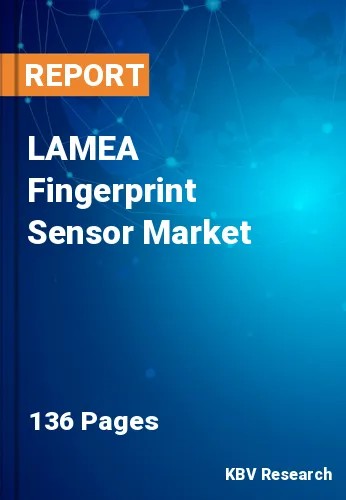The Latin America, Middle East and Africa Fingerprint Sensor Market would witness market growth of 16.2 % CAGR during the forecast period (2023-2030). In the year 2026, the LAMEA market's volume is expected to surge to 13,247.1 thousand units, showcasing a growth of 18.1 % (2023-2030).
The trend toward multi-modal biometrics involves combining fingerprint sensors with other biometric technologies, such as facial recognition or iris scanning. This multi-layered approach enhances overall security and authentication accuracy. It also provides flexibility in choosing the most appropriate biometric modality based on the specific requirements of different applications. While 2D fingerprint recognition has been the norm for quite some time, the market is witnessing a shift towards in-display 3D fingerprint recognition. This technology adds an extra layer of security by capturing not just the surface features but also the depth of the fingerprint, making it more resilient to spoofing or replication attempts.
Fingerprint sensors are increasingly utilizing a fusion of capacitive and optical sensing technologies. This hybrid approach combines the advantages of both technologies, resulting in improved accuracy, reliability, and performance across different environmental conditions. The focus on energy efficiency has led to the development of fingerprint sensors that consume minimal power. Energy-efficient sensors contribute to longer battery life in devices and are particularly relevant in applications like smartphones and wearables. Innovations in sensor materials have led to the development of transparent and flexible fingerprint sensors.
Fingerprint sensors contribute to home security systems by offering biometric arm and disarm functions in the UAE. Fingerprint sensors play a role in smart lighting control in the UAE, allowing users to activate personalized lighting scenes based on their preferences. Fingerprint sensors contribute to the secure control of automated window blinds and curtains in the UAE. Fingerprint sensors can be used for biometric activation of intruder alert systems in the UAE. Fingerprint sensors enable secure control of smart irrigation systems for gardens in the UAE. Users can set watering schedules and adjust settings through biometric authentication in the UAE. Fingerprint sensors contribute to automated pet care systems, allowing residents to securely interact with pet feeding, monitoring, and care devices in the UAE. Fingerprint sensors provide secure access to parcel delivery services in the UAE. Hence, due to these aspects, the market will expand across the LAMEA region in upcoming years.
The Brazil market dominated the LAMEA Fingerprint Sensor Market, by Country in 2022, and would continue to be a dominant market till 2030; thereby, achieving a market value of $215.5 Million by 2030. Argentina market is showcasing a CAGR of 16.9% during (2023 - 2030). Additionally, The UAE market would register a CAGR of 15.9% during (2023 - 2030).
Free Valuable Insights: The Worldwide Fingerprint Sensor Market is Projected to reach USD 10.7 Billion by 2030, at a CAGR of 13.2%
Based on Technology, the market is segmented into Capacitive, Thermal, Optical, and Others. Based on Vertical, the market is segmented into Consumer Electronics, Government & Defense, BFSI, Healthcare, Commercial Security, Smart Homes, Travel & Immigration, and Others. Based on countries, the market is segmented into Brazil, Argentina, UAE, Saudi Arabia, South Africa, Nigeria, and Rest of LAMEA.
By Technology (Volume, Thousand Units, USD billion, 2019-2030)
By Vertical (Volume, Thousand Units, USD billion, 2019-2030)
By Country (Volume, Thousand Units, USD billion, 2019-2030)
Our team of dedicated experts can provide you with attractive expansion opportunities for your business.

